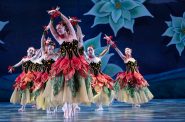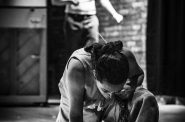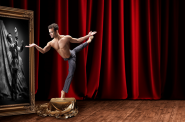the power of collaboration
Danceworks invited dancers, choreographers, set designers, musicians and composers to prove that two brains (or more) are better than one. "Intersect" premieres this weekend at their Water St. studio.
Danceworks’ Art to Art event over the summer was a splendor of collaborative efforts, ranging from quirky to creepy to lavish and everywhere in between. Their upcoming Intersect performances will surely carry the same effectiveness that comes from pairing creative minds.
I spoke with a slew of the involved artists, each of them eager to describe their collaborative works. Many were still in a formative stage, allowing discoveries in rehearsals to bend and change their visions.
“Whatever success comes from the intersection will be up to chance,” said Laura Murphy, who directs an untitled improvisational piece. “We’re trying to create ‘happy accidents’ by coincidence.”
Murphy’s dance will certainly be the most loosely structured of the bunch, relying on the creativity of its “movers” to determine the ebb and flow and tone.
Murphy collaborated with experimental vocal composer Amanda Schoofs for the dance’s score. Schoofs flung black paint across paper, then zeroed-in or zoomed-out on specific patterns she found inspiring. These sprays, dots and swooshes were then transferred to 4×6 notecards, which the musicians will arrange (9 for each) in any order and use as their score. The improvisational musicians include Steve Schlei (iPad), David Collins (saxophone) and Trevor Saint (glockenspiel). The men will pair up for the performances, meaning each night will feature a completely different aesthetic, depending on which two instruments collaborate.
“It will be vastly different every time, and that’s the nature of the beast,” said Murphy. “Danceworks dancers are so versatile, willing to go outside of their comfort zone and play with it. They just go for it.”
The women of Cadance Collective—Emma Koi, Alicia Storin and Christal Wagner—teamed up with dancer Melissa Anderson for Um, ok…Now Let’s Move On, a piece that accidentally stumbled upon its score after an afternoon of playing the childhood game MASH at Colectivo.
“During that conversation we talked about using voice from podcasts and the cadence of voice, riffing on it to make music,” said Wagner. “We originally thought about using an already-composed piece, but during our conversation we kind of went on a tangent and played MASH. Alicia had never played, and we recorded the MASH conversation and what emerged, with Emma asking the questions, were some interesting thoughts about, as adults, what we want our future to be, even though we are in our future, you know? We listened to it in our first rehearsal and thought, why don’t we use this as inspiration?”
Wagner messed with the recording to create rhythm, and Storin and Koi composed music using phrases like “if you had a super power,” “this is your fantasty world,” “you only live the good parts,” “you don’t even feel guilty when you eat this thing,” and so on.
“The choreography is along those lines of creating your future, and it goes through a range of emotions from comical to somber to thoughtful,” said Wagner, who will dance with Anderson in the duet. “The dance accompanies and contrasts the music. Spoken word generated the movement. Even though the text may go away, the movement carries on from where the words used to be. It’s a study on thought, but there’s really no through-line, and we’re not attached to those as performers.”
“It works in the same way a conversation bops around,” said Anderson. “Or your life,” she added, laughing.
Gina Laurenzi’s piece, Beneath, employs more of an ethereal soundscape score to transform her choreography. Improvisational composer Matt Martell created the music to pair with Laurenzi’s vision of deep-sea movement.
“What I like to do with my work in general is to create an alternate world,” said Laurenzi. “I like to feel like I’m transforming the whole room, not just that I’m moving in it.”
To achieve that even further, Laurenzi will use a film projection to add texture to the space. She mostly spoke about the power of the musical composition, and how she intends to marry the choreography to it while avoiding any matchy-matchy moments.
“I’m playing with that watery, fluid quality. I have a trickling of gestures that get tossed into larger moments, that might look more technical—a familiar leg that the audience recognizes as classical. It builds, and dies, and grows from the ground. Matt has a wild imagination, so when I talk to him about what I’m trying to achieve, he goes back home and puts a sound score together on his computer, and he’s really good at creating a world. It’s mysterious. Sometimes I don’t match the movement to the music, and then there will be a noise where I hit that accent every time, which makes it more important.”
This is Laurenzi’s first season with Danceworks. In addition to choreographing, directing and starring in Beneath, she will appear in three of the other Intersect pieces.
A Product of Distance is a collaboration between Christina Briggs-Winslow, Edward Winslow and Tim Russell, an extension of their “Arts Intersect” program held in the spring at UWM.
“We wanted to create an arts symposium in Milwaukee, where people of varying artistic disciplines could come together and dialogue—to explore at a basic level what the other does, and have a conversation. It was fascinating what came out of it; teaching a technique class with a musical focus.”
Russell lead the musical focus of the program, while Briggs-Winslow and Winslow headed up choreography. In some ways this piece is an extension of that symposium, extending the music dialogue through Russell’s composition.
“It’s a combination of synthesized sounds and natural sounds, or the real and not-real world,” said Russell. “Beyond the actual sounds, what I was trying to do was use music as a way to direct your focus. If we’re going to talk about musical ideas and dance and how they function together, we definitely should use music to see how it can be a wash behind this room that we exist in, and also how it can draw you into certain connections. It’s a nice ability when you’re working with computer music to just be able to do a draft in a day—it enables the piece to keep living and living, with lots of swatches that I can present.”
In regards to the choreography, Briggs-Winslow emphasized the dance’s central set piece, created by Winslow—something of a tent that will be the focus and act as several metaphors.
“Basically it’s a structure on stage that allows us to have an inner world and an outer world,” said Briggs-Winslow. “It provides a lens, and sort of changes its function—sometimes it looks like a cocoon, or it might look like a womb. We also have projections from Kate Price, who has done these amazing things that we mostly took from the idea of transparency and enclosure—a permeable barrier. That’s reflected in the relationships of the dancers on stage as well. We look at the intimacy you can have with someone, and what can happen when you’re isolated from it.”
The trio has been in the same room all together maybe once, creating the piece instead through a huge drop-box of ideas. The piece will use six dancers.
“I love the interdisciplinary aspect of Intersect,” said Briggs-Winslow. “We want to be inclusive of all the amazing artists that are here in the city.”
Danceworks’ Intersect also includes Laws and Logic, a piece by DPC’S artistic director Dani Kuepper. Intersect premieres Friday, Nov. 15 and runs through Nov. 24. Showtimes are at 7:30 p.m. Fridays and Saturdays, 2:30 p.m. on Sundays, with one Thursday show at 8 p.m. Nov. 21. Tickets are $20, available online or call (414) 277-8480 ext. 6025.
Dance
-
Milwaukee Ballet Brings Back Orchestra
 Jul 14th, 2025 by Bruce Murphy
Jul 14th, 2025 by Bruce Murphy
-
New Riverwest Company, Production Impresses
 Feb 10th, 2020 by Brendan Fox
Feb 10th, 2020 by Brendan Fox
-
Milwaukee Ballet Show Remakes History
 Feb 10th, 2020 by Catherine Jozwik
Feb 10th, 2020 by Catherine Jozwik
























